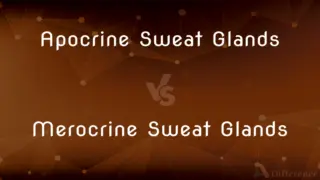Lattice vs. Grid — What's the Difference?
By Maham Liaqat & Urooj Arif — Updated on March 19, 2024
"Lattice" refers to a structure of crossed wooden or metal strips, often used decoratively, whereas "grid" denotes a network of evenly spaced lines intersecting at right angles, used for various purposes.

Difference Between Lattice and Grid
Table of Contents
ADVERTISEMENT
Key Differences
A lattice is typically a framework consisting of strips of wood, metal, or another material that cross over each other, forming a pattern of spaces. It's often used in gardens for climbing plants or as a decorative element in windows and fences. On the other hand, a grid is a more abstract concept, referring to a network of horizontal and vertical lines that intersect at right angles to form a uniform pattern of squares or rectangles. Grids are utilized in a wide range of applications, from graphic design and city planning to the layout of spreadsheets and maps.
While lattices are primarily used for their aesthetic appeal and physical functionality, such as supporting plants or serving as part of a structure, grids serve as organizational or navigational tools. For instance, a city's streets arranged in a grid pattern facilitate easy navigation and planning, whereas a lattice might be employed for its visual or functional qualities in architecture and design.
The material composition of a lattice adds a tangible aspect to its definition, implying a physical presence with specific uses in construction and design. In contrast, a grid can be both a physical object (like a metal grid on a drain) or an intangible concept used in digital interfaces and graphical layouts.
Lattices often exhibit a more ornamental design, with patterns that can be simple or intricate, reflecting cultural or personal aesthetic preferences. Grids, while they can be aesthetically pleasing, are valued more for their functionality in organizing space and information, emphasizing clarity and efficiency over decoration.
Comparison Chart
Definition
A structure of crossed strips forming a pattern
A network of intersecting lines forming squares
ADVERTISEMENT
Primary Use
Decorative, support for plants, architecture
Organization, navigation, design, layout
Material Composition
Wood, metal, other materials
Not material-specific; can be conceptual
Functionality
Aesthetic appeal, physical support
Organizational tool, layout, mapping
Design
Often ornamental, with varied patterns
Functional, uniform, emphasizes clarity
Compare with Definitions
Lattice
A structure made of crisscrossed strips.
The garden's lattice was covered in climbing roses.
Grid
An alignment aid in various fields.
Photographers use grid lines in the viewfinder for balanced compositions.
Lattice
A pattern formed by intersecting strips.
The pie crust was designed with a lattice pattern on top.
Grid
A network of horizontal and vertical lines.
The city was planned on a strict grid pattern.
Lattice
Support structure for plants.
We installed a wooden lattice for the ivy to grow on.
Grid
A framework for organizing information.
Data was entered into a spreadsheet grid for analysis.
Lattice
A structural element in construction.
Lattice beams were used in the construction of the pavilion.
Grid
Layout tool in design and planning.
The designer used a grid to organize the content on the webpage.
Lattice
Decorative framework used in architecture.
The lattice windows added a historical charm to the house.
Grid
A physical or conceptual structure.
A metal grid covered the drain to prevent blockage.
Lattice
An open framework made of strips of metal, wood, or similar material overlapped or overlaid in a regular, usually crisscross pattern.
Grid
A framework of crisscrossed or parallel bars; a grating or mesh.
Lattice
A structure, such as a window, screen, or trellis, made of or containing such a framework.
Grid
A cooking surface of parallel metal bars; a gridiron.
Lattice
Something, such as a decorative motif or heraldic bearing, that resembles an open, patterned framework.
Grid
Something resembling a framework of crisscrossed parallel bars, as in rigidity or organization
The city's streets form a grid.
Lattice
A regular, periodic configuration of points, particles, or objects throughout an area or a space, especially the arrangement of ions or molecules in a crystalline solid.
Grid
A pattern of regularly spaced horizontal and vertical lines forming squares on a map, a chart, an aerial photograph, or an optical device, used as a reference for locating points.
Lattice
The spatial arrangement of fissionable and nonfissionable materials in a nuclear reactor.
Grid
An interconnected system for the distribution of electricity or electromagnetic signals over a wide area, especially a network of high-tension cables and power stations.
Lattice
To construct or furnish with a lattice or latticework.
Grid
A corrugated or perforated conducting plate in a storage battery.
Lattice
A flat panel constructed with widely-spaced crossed thin strips of wood or other material, commonly used as a garden trellis.
Grid
(Football) The gridiron.
Lattice
(heraldry) A bearing with vertical and horizontal bands that cross each other.
Grid
(Sports) The starting positions of cars on a racecourse.
Lattice
(crystallography) A regular spacing or arrangement of geometric points, often decorated with a motif.
Grid
A rectangular array of squares or rectangles of equal size, such as in a crossword puzzle.
Lattice
(group theory) A discrete subgroup of Rn which is isomorphic to Zn (considered as an additive group) and spans the real vector space Rn.
Grid
A tiling of the plane with regular polygons; a honeycomb.
Lattice
(music) A model of the tuning relationships of a just intonation system, comprising an array of points in a periodic multidimensional pattern.
Grid
A system for delivery of electricity, consisting of various substations, transformers and generators, connected by wire.
Lattice
A discrete subgroup L of a given locally compact group G whose quotient space G/L has finite invariant measure.
Grid
(computing) A system or structure of distributed computers working mostly on a peer-to-peer basis, used mainly to solve single and complex scientific or technical problems or to process data at high speeds (as in clusters).
Lattice
A partially ordered set in which every pair of elements has a unique supremum and a unique infimum.
Grid
(cartography) A method of marking off maps into areas.
Lattice
To make a lattice of.
To lattice timbers
Grid
(motor racing) The pattern of starting positions of the drivers for a race.
Lattice
To close, as an opening, with latticework; to furnish with a lattice.
To lattice a window
Grid
(electronics) The third (or higher) electrode of a vacuum tube (triode or higher).
Lattice
Any work of wood, metal, plastic, or other solid material, made by crossing a series of parallel laths, or thin strips, with another series at a diagonal angle, and forming a network with openings between the strips; as, the lattice of a window; - called also latticework.
The mother of Sisera looked out at a window, and cried through the lattice.
Grid
(electricity) A battery-plate somewhat like a grating, especially a zinc plate in a primary battery, or a lead plate in a secondary or storage battery.
Lattice
The representation of a piece of latticework used as a bearing, the bands being vertical and horizontal.
Grid
A grating of parallel bars; a gridiron.
Lattice
The arrangement of atoms or molecules in a crystal, represented as a repeating arrangement of points in space, each point representing the location of an atom or molecule; called also crystal lattice and space lattice.
Grid
An openwork ceiling above the stage or studio, used for affixing lights etc.
Lattice
To make a lattice of; as, to lattice timbers.
Grid
To mark with a grid.
Lattice
To close, as an opening, with latticework; to furnish with a lattice; as, to lattice a window.
Therein it seemeth he [Alexander] hath latticed up Cæsar.
Grid
To assign a reference grid to.
Lattice
An arrangement of points or particles or objects in a regular periodic pattern in 2 or 3 dimensions
Grid
A grating of thin parallel bars, similar to a gridiron.
Lattice
Small opening (like a window in a door) through which business can be transacted
Grid
A plate or sheet of lead with perforations, or other irregularities of surface, by which the active material of a secondary battery or accumulator is supported.
Lattice
Framework consisting of an ornamental design made of strips of wood or metal
Grid
A mesh or coil of fine wire in an electron tube, connected to the circuit so as to regulate the current passing through the tube.
Grid
Any network of crossing horizontal and vertical lines; - they are used, for example, as reference coordinates to locate objects or places on a map.
Grid
Anything resembling a grid{4}, as the Manhattan street grid. See also gridlock.
Grid
A network of connected conductors for distributing electrical power, especially one using high-tension lines for wide geographic distribution of power; as, the Northeast power grid.
Grid
The gridiron.
Grid
A system of high tension cables by which electrical power is distributed throughout a region
Grid
A network of horizontal and vertical lines that provide coordinates for locating points on an image
Grid
An electrode placed between the cathode and anode of a vacuum tube to control the flow of electrons through the tube
Grid
A cooking utensil of parallel metal bars; used to grill fish or meat
Common Curiosities
Can a grid be considered a type of lattice?
While both involve intersecting lines, grids are primarily for organization, not decorative purposes, making them distinct from lattices.
Is a grid always visible?
No, grids can be conceptual, such as in planning, or visible in designs and physical structures.
How do grids aid in web design?
They help designers organize elements on a page clearly and consistently, enhancing usability.
How do grids contribute to the functionality of spreadsheets?
They organize data into rows and columns for easy entry, calculation, and analysis.
How does the concept of a grid extend to digital interfaces?
It helps in structuring content, ensuring a clean, accessible, and visually appealing layout.
How do lattices contribute to architecture?
They add aesthetic appeal and can provide structural support for climbing plants or as part of building designs.
What makes a grid useful in city planning?
It simplifies navigation and land use planning by dividing space into predictable, easy-to-navigate units.
Why are grids important in maps and charts?
They facilitate accurate measurement, placement, and navigation by providing a reference system.
Are there cultural differences in lattice designs?
Yes, lattice designs can vary widely, reflecting different architectural styles and cultural aesthetics.
What distinguishes a lattice from a grid?
A lattice is a crossed structure often used decoratively, while a grid is a network of intersecting lines used for organization and layout.
Are lattices always made of wood or metal?
Typically, but they can be made from any material that can form a crossed pattern.
Can lattices serve functional purposes beyond decoration?
Yes, they can provide support for plants or act as privacy screens while still being decorative.
What is the significance of material in lattice construction?
The choice of material affects the lattice's durability, appearance, and suitability for specific applications.
What is a key feature of a lattice in gardens?
Its ability to support climbing plants, adding vertical interest and greenery.
Can lattices be used indoors?
Yes, as decorative elements in window designs, room dividers, and more.
Share Your Discovery

Previous Comparison
Victim vs. Casualty
Next Comparison
Circle vs. CircuitAuthor Spotlight
Written by
Maham LiaqatCo-written by
Urooj ArifUrooj is a skilled content writer at Ask Difference, known for her exceptional ability to simplify complex topics into engaging and informative content. With a passion for research and a flair for clear, concise writing, she consistently delivers articles that resonate with our diverse audience.














































